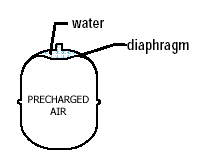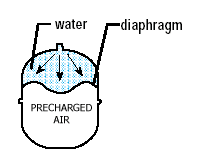What is Thermal Expansion?
When water is heated it expands. For example, water heated from 90°F to a thermostat setting of 140°F in a 40 gallon hot water heater will expand by almost one-half gallon. This is because when water is heated, its density decreases and its volume expands (see below). Since water is not compressible, the extra volume created by expansion must go someplace. During no-flow periods in a system, pressure reducing valves, backflow preventers, and other one-way valves are closed, thus eliminating a path for expanded water to flow back to the system supply. Hence, system pressure increases.

Temperature vs Density
Thermal expansion of water in a closed plumbing system can create a number of annoying and potentially dangerous problems. These include: the build up of unusually high pressure in a system (even when a pressure reducing valve is installed); pressure surges; and the chronic or continuous dripping of a temperature and pressure (T&P) relief valve. In addition, dripping faucets and leaking toilet tank ball cock fill valves are also symptomatic of thermal expansion.
More serious problems can also occur due to thermal expansion. When dangerous pressures are built up in a water heater, internal parts may fail such as the internal flues, fittings or water connections. If a flue way collapses it can lead to the potential release of toxic gases, such as carbon monoxide into living spaces. Thermal expansion can also lead to a ruptured or distorted hot water heating tank and may void the manufacturer’s warranty.
Plumbing Code Requirements
Plumbing codes require that thermal expansion control be addressed in plumbing systems. A temperature and pressure relief valve is not considered a thermal expansion device. This is because when water is allowed to continuously drip from the T&P relief valve, minerals from the water can build up on the valve, eventually blocking it. This blockage can render the T&P valve useless and potentially lead to hot water heater explosions. The International Plumbing Code (IPC), Uniform Plumbing Code (UPC) and Standard Plumbing Code all require thermal expansion control to be addressed.
Expansion Tanks – How a Diaphragm Expansion Tank Works
When water is heated in a closed system it expands. Water is not compressible, therefore, the additional water volume created has to go someplace. When an expansion tank is installed the excess water enters the pre-pressurized tank (figure 1). As the temperature and pressure reaches its maximum, the diaphragm flexes against an air cushion (air is compressible) to allow for increased water expansion (figure 2). When the system is opened again or the water cools, the water leaves the tank and returns to the system.
figure 1. As the water temperature increases, the expanded water is received by the tank.
figure 2. As the water and pressure reaches its maximum, the diaphragm flexes against the air cushion (air is compressible) to allow for increased water expansion.



Leave A Comment
You must be logged in to post a comment.